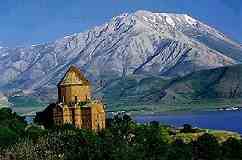The province of Van sits by Lake Van, and was the ancient Urartian capital of Tuspa. It is situated in a green, fertile oasis in the midst of rocky mountains in the Eastern Anatolian region of Turkey. An impressive citadel stands on one of these peaks and dates back to the 9th century BC. There are steps carved into rock leading to the fortress, and while descending you will be able to see some cuneiform inscriptions paying homage to Persian King, Xerxes of the 5th century BC. In the fortress, the Urartian royal tombs are of interest. The surrounding area is full of Urartian remains. In the old city there are many mosques and mausoleums such as the Ulu Mosque, the Hüsrev Pasa Mosque, the Kaya Çelebi Mosque and the Ikiz Kümbet. The Archaeological Museum in the new city exhibits the Urartian finds. At Van Harbor you may find pleasant places to rest. For swimming and camping you may head for Edremit, 14 kilometers (9 miles) to the southwest. It is a holiday resort center from where you may do some sightseeing excursions. At Gevas, there is a Seljuk graveyard, filled with extraordinary headstones, as well as the lovely Halime Hatun Tomb.
The eruption of Nemrut volcano led the formation of the largest lake in Turkey; Van and the deepest lake; Nemrut (it is not the same Nemrut mountain in Adiyaman province). Urartus, Armenians, Kurds, Arabians, Romans, Seljuks, Ottomans, Byzantines all met on this gorgeous land.
 Lake Van is the largest lake in Turkey (1.646 meters high above sea level and covers an area of 3.713 square kilometers) and provides good opportunities for enjoyable excursions. You may go for outdoor sports such as trekking or hunting in the mountains surrounding it, especially Mount Süphan, the second highest mountain in Turkey after Mount Ararat. Alternatively you may head for on the beach, or visit the Urartian sites and Turkish cultural centers. The islands on the lake are also interesting, most of them housing many monasteries and churches. The most important of these is the Akdamar Island with its 10th century church of Holy Cross. The church is now restored as a museum and its richly decorated walls have Old Testament relieves. After visiting the museum you may rest at the beneath lakeside the almond trees, where there are good opportunities for picnicking and swimming. Carpanak Island is also interesting and deserves a visit. Hosab, 67 kilometers (42 miles) east, has a magnificent old fortress fronted by huge walls. At Cavustepe, there is an Urartian site, which is 25 kilometers (15 miles) from Van on the Hakkari road.
Lake Van is the largest lake in Turkey (1.646 meters high above sea level and covers an area of 3.713 square kilometers) and provides good opportunities for enjoyable excursions. You may go for outdoor sports such as trekking or hunting in the mountains surrounding it, especially Mount Süphan, the second highest mountain in Turkey after Mount Ararat. Alternatively you may head for on the beach, or visit the Urartian sites and Turkish cultural centers. The islands on the lake are also interesting, most of them housing many monasteries and churches. The most important of these is the Akdamar Island with its 10th century church of Holy Cross. The church is now restored as a museum and its richly decorated walls have Old Testament relieves. After visiting the museum you may rest at the beneath lakeside the almond trees, where there are good opportunities for picnicking and swimming. Carpanak Island is also interesting and deserves a visit. Hosab, 67 kilometers (42 miles) east, has a magnificent old fortress fronted by huge walls. At Cavustepe, there is an Urartian site, which is 25 kilometers (15 miles) from Van on the Hakkari road.
 88 kilometers (55 miles) north of Van, are the Muradiye Waterfalls, perfect place to rest while listening to natures harmony at one of the restaurants or tea gardens around the falls.
88 kilometers (55 miles) north of Van, are the Muradiye Waterfalls, perfect place to rest while listening to natures harmony at one of the restaurants or tea gardens around the falls.
Van is also famous for its Van cat, a pure white, longhair cat which has the strange feature of one blue eye and the other green.
Very few people know Tirsin pasture in Van. The rocky area of this 2.400 meters (7.874 feet) high pasture is an open air museum. There are thousands of pictures on thousands of rocks: Schematic pictures of Taurus, bison dating back to ages between Mesolithic times and bronze age. These pictures created by the hunters support the thesis that the area was thickly forested in prehistoric times.
A 7,2 magnitude earthquake hit Van and its district Ercis on 23rd of October 2011, at 13:41 local time. Over 644 people were killed and thousands were injured and lost their homes.

